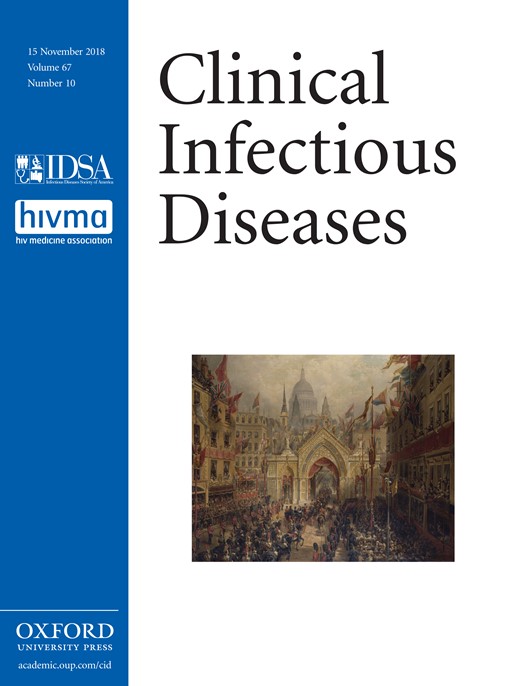
Cover image

Volume 67, Issue 10, 15 November 2018
NEWS
News
IN THE LITERATURE
In the Literature
IDSA FEATURES
Hepatitis C Guidance 2018 Update: AASLD-IDSA Recommendations for Testing, Managing, and Treating Hepatitis C Virus Infection
COMMENTARY
Universal Screening of Pregnant Women for Hepatitis C: The Time Is Now
Currently, risk-based hepatitis C virus (HCV) screening is recommended for women of childbearing age and pregnant women despite a high HCV prevalence. For many reasons outlined here, the time has come for universal screening for HCV for all pregnant women.
ARTICLES AND COMMENTARIES
Effectiveness of 13-Valent Pneumococcal Conjugate Vaccine Against Hospitalization for Community-Acquired Pneumonia in Older US Adults: A Test-Negative Design
Our study demonstrated real-world, direct effectiveness of 13-valent pneumococcal conjugate vaccine against vaccine-type community-acquired pneumonia following introduction into a routine immunization program among adults aged ≥65 years, many of whom had immunocompromising and chronic medical conditions.
Burden and Risk Factors for Coronavirus Infections in Infants in Rural Nepal
Human coronaviruses (HCoVs) are associated with respiratory illnesses in infants aged 0–6 months in a rural South Asian setting. HCoV incidence increases beyond the first month of life. Four tested species (229E, OC43, NL63, HKU1) were present.
Effects of Water, Sanitation, Handwashing, and Nutritional Interventions on Child Enteric Protozoan Infections in Rural Bangladesh: A Cluster-Randomized Controlled Trial
The trial found that individual handwashing and sanitation interventions significantly reduced childhood Giardia infections. Combined interventions provided no additional benefit. To reduce Giardia infection, individual interventions may be more feasible and cost-effective than combined interventions in similar rural, low-income settings.
Imprinting of Repeated Influenza A/H3 Exposures on Antibody Quantity and Antibody Quality: Implications for Seasonal Vaccine Strain Selection and Vaccine Performance
Influenza antibodies from hosts with preexisting immunity showed broader cross-reactivity than those without preexisting immunity. Repeated influenza exposures imprinted both antibody quantity and antibody quality. To improve vaccine effectiveness, vaccine strain selection needs to consider the preexisting immunity in humans.
What Happens Next Depends on What Happened First
Seroprevalence of Herpes Simplex Virus Types 1 and 2 Among Pregnant Women and Sexually Active, Nonpregnant Women in the United States
Herpes simplex virus type 1/2 (HSV-1/2) seroprevalence was stable among pregnant women between 1999–2006 and 2007–2014. HSV-1/-2 seronegativity increased among those with ≤3 sex partners highlighting vulnerability to primary HSV infection and increased risk of neonatal herpes.
Comparison of the Cumulative Efficacy and Safety of Chloroquine, Artesunate, and Chloroquine-Primaquine in Plasmodium vivax Malaria
Vivax malaria relapses frequently even in low-transmission settings. Chloroquine delays but does not prevent recurrences. Adding primaquine to a slowly eliminated schizonticide significantly reduces recurrences and improves hematocrit, but this advantage is offset by hemolysis in G6PD-deficient females.
A Statewide Antibiotic Stewardship Collaborative to Improve the Diagnosis and Treatment of Urinary Tract and Skin and Soft Tissue Infections
Twenty-six hospitals participated in a statewide collaborative to improve the diagnosis and treatment of inpatient urinary tract and skin infections. Overall performance targets for the collaborative were partially met; however, a number of hospitals achieved substantial changes in prescribing.
Continuous Invasion by Respiratory Viruses Observed in Rural Households During a Respiratory Syncytial Virus Seasonal Outbreak in Coastal Kenya
This is the first household study of multiple respiratory viruses in a low-income setting that used intensive sampling regardless of symptoms. There was a remarkably high frequency of virus infection and illness, demonstrating the opportunity for complex interactions.
Adverse Events Associated With Antibiotics and Intravenous Therapies for Post–Lyme Disease Syndrome in a Commercially Insured Sample
In a retrospective cohort analysis of claims data, patients receiving antibiotic/immunomodulatory pharmacotherapy for post–Lyme disease syndrome (PLDS) had greater 90-day incidence of all-cause hospitalizations, all-cause emergency department visits, infections, and electrolyte abnormalities, compared with PLDS patients not receiving such therapies.
Cumulative Burden of Depression and All-Cause Mortality in Women Living With Human Immunodeficiency Virus
We observed a dose–response relationship between the cumulative burden of depression and all-cause mortality among women living with human immunodeficiency virus (HIV). Shortening the duration of depressive episodes through enhanced treatment protocols in HIV primary care settings may interrupt accumulation of mortality risk.
Factors Influencing Selection of Infectious Diseases Training for Military Internal Medicine Residents
Similar factors affect career choice among military internal medicine residents and their civilian counterparts, including mentorship, learning style, and salary. Recruitment strategies for infectious (ID) diseases physicians should focus on residency opportunities, considering reasons for continued interest in military ID.
A Trial of a Single-tablet Regimen of Elvitegravir, Cobicistat, Emtricitabine, and Tenofovir Disoproxil Fumarate for the Initial Treatment of Human Immunodeficiency Virus Type 2 Infection in a Resource-limited Setting: 48-Week Results From Senegal, West Africa
Our trial of a single-tablet regimen containing elvitegravir, cobicistat, emtricitabine, and tenofovir disoproxil fumarate in antiretroviral therapy–naive HIV-2–infected individuals for 48 weeks, in a resource-limited setting, demonstrated favorable immunovirologic outcomes and was well tolerated.
Less Severe but Prolonged Course of Acute Hepatitis A in Human Immunodeficiency Virus (HIV)–Infected Patients Compared With HIV-Uninfected Patients During an Outbreak: A Multicenter Observational Study
During an AHA outbreak, we found that HIV-infected patients had a lower severity, but delayed resolution, of AHA than HIV-uninfected patients. Better viral suppression by cART alleviated the impact of HIV infection on the disease course of AHA in HIV-infected patients.
Burden, Etiology, and Risk Factors of Respiratory Virus Infections Among Symptomatic Preterm Infants in the Tropics: A Retrospective Single-Center Cohort Study
This study describes the burden of respiratory virus infections (RVIs) among preterm infants in the tropics. RVIs affected >1 of 10 infants born at ≤32 weeks’ gestation before age 2 years, with respiratory syncytial virus being the main causative pathogen.
BRIEF REPORTS
Breakthrough Fungal Infections in Patients With Leukemia Receiving Isavuconazole
Rotavirus Vaccination Is Associated With Reduced Seizure Hospitalization Risk Among Commercially Insured US Children
Effect of Antiretroviral Therapy on Plasma Concentrations of Chloroquine and Desethyl-chloroquine
Plasma concentrations of chloroquine and desethyl-chloroquine did not differ among individuals receiving protease inhibitor-based antiretroviral therapy (ART) (n = 9), efavirenz-based ART (n = 15), other ART (n = 8), or no ART (n = 31). Efavirenz appeared to inhibit chloroquine desethylation.
INVITED ARTICLE
IMMUNOCOMPROMISED HOSTS
Breakthrough Invasive Mold Infections in the Hematology Patient: Current Concepts and Future Directions
Despite the effectiveness of mold-active prophylaxis, breakthrough invasive mold infections (bIMIs) are encountered in high risk hematology patients. This viewpoint outlines different clinical scenarios and presents the diagnostic and treatment challenges of bIMIs in that patient population.



